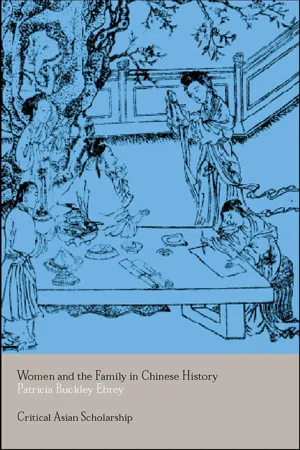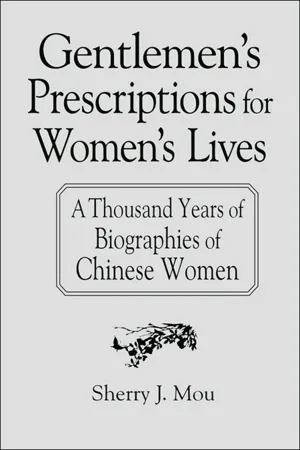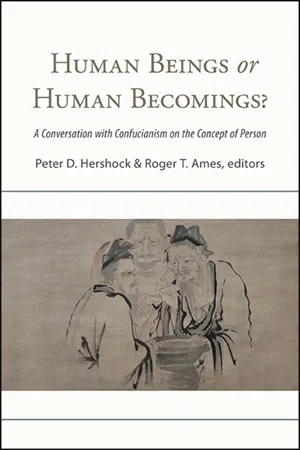History
Women in the Song Dynasty
During the Song Dynasty, women's roles and status in Chinese society were influenced by Confucian ideals, which emphasized women's domestic roles and subordination to men. However, some women in the Song Dynasty were able to attain education and participate in literary and artistic pursuits, contributing to the cultural and intellectual life of the time. Despite these opportunities, women's rights and freedoms were still limited.
Written by Perlego with AI-assistance
Related key terms
4 Key excerpts on "Women in the Song Dynasty"
- eBook - ePub
- Patricia Ebrey(Author)
- 2003(Publication Date)
- Routledge(Publisher)
*Most historians of China have heard the charge that the revival of Confucianism in the Song period initiated a decline in the status of women. The principal accusations are that Neo-Confucianism fostered the seclusion of women, footbinding, and the cult of widow chastity. It is widely recognized that these constraints on women had become more oppressive by the Qing dynasty, but their roots are traced back to the Song period.1 Cheng Yi’s (1033–1107) statement that “To starve to death is a small matter, but to lose one’s chastity is a great matter” is commonly blamed for much of the misery of women in late imperial China.The evidence offered to support these charges is of several sorts. In his Zhongguo funü shenghuo shi (History of Chinese Women’s Lives), written in 1928, Chen Dongyuan argued that women’s lives started to deteriorate after Cheng Yi and Zhu Xi (1130–1200) promoted “the idea that women must value chastity.” Thus “the Song really was the turning point in women’s lives.”2 More recently, Zhu Ruixi, after examining a wide range of evidence concerning views on women and marriage in the Song, concluded that these attitudes gradually hardened during the Song, bringing in divorce as well as remarriage.Especially from the time of Song Lizong [r.1225–1264], because of the honor granted Neo-Confucianism in the intellectual sphere, the right of women to seek divorces was almost completely eliminated, and their right to remarry after the death of their husbands decreased every day.3Popularizers and polemicists have been quicker to assert the influence of Neo-Confucianism on female seclusion, footbinding, and even female infanticide. Lin Yutang in My Country and My People and Howard Levy in Chinese Footbinding report that Zhu Xi, while prefect of Zhangzhou in southern Fujian, promoted footbinding as a way to foster the separation of men and women and encourage chastity by making it difficult for women to move about.4 Feminists have picked up these charges. Elisabeth Croll writes that “the Neo-Confucian philosophers of the Song dynasty (960–1267) further elaborated the code of feminine ethics by re-emphasizing the practices of segregation and seclusion, and introducing the practice of bound feet.”5 Esther Yao states that “Infanticide was extremely prevalent in the Song Dynasty–being greatly influenced by the philosophy of Neo-Confucianism which denied women basic human rights, including the right to live.”6 Authors of textbooks have also incorporated these charges against Neo-Confucianism. Dun J. Li, in his textbook for American students, The Ageless Chinese: A History - eBook - ePub
Gentlemen's Prescriptions for Women's Lives: A Thousand Years of Biographies of Chinese Women
A Thousand Years of Biographies of Chinese Women
- Sherry J. Mou(Author)
- 2015(Publication Date)
- Routledge(Publisher)
1 From The Biographies of Women to the Biographies of Chaste Women Introduction China has a fairly continuous tradition of written records that goes back about four thousand years. Many of those records consist of historical documentation. Therefore, it should be possible to establish a much longer history of women in China than elsewhere, despite the fact that nearly all historical documents were written by men and focused on the affairs of men. The last quarter of the twentieth century saw a flourishing of studies of women’s histories in the West. The last two decades’ increasing fresh focus on topics related to women in Chinese studies indicates that scholars are indeed striving to establish a longer history of Chinese women. 1 Most studies focus on late imperial China, especially the Ming and Qing dynasties 2 and the period from the late Qing to the present. For example, Meng Yue and Dai Jinhua’s Fu chu lishi dibiao (Voices emerging into the foreground of history: A study of contemporary Chinese women’s literature) reexamines the consciousness of the male authors of the May Fourth generation and maps out a genealogy for the female writers of the twentieth century. 3 Susan Mann’s Precious Records looks at how, building upon China’s long history of men’s writing about women, Qing women went further to try to build their own version of women’s history. Patricia Buckley Ebrey’s study of Women in the Song Dynasty pushed class to the foreground, showing how upper-class and peasant women’s lives differed. While upper-class women remained mostly “inside helpers,” peasant women’s work often involved frequent coming and going between the house and the fields. 4 Such women-centered and women-based studies challenge the beliefs, prevalent since the nineteenth century, that Chinese women are helpless victims of traditional Chinese culture and that their salvation will come only from the new learning and new value system of the West - eBook - ePub
SUNY series in Chinese Philosophy and Culture
A Conversation with Confucianism on the Concept of Person
- Peter D. Hershock, Roger T. Ames, Peter D. Hershock, Roger T. Ames(Authors)
- 2021(Publication Date)
- SUNY Press(Publisher)
41Ming dynasty gentry were often accommodating, even indulgent toward their daughters, partly in reaction against “the rigid gender prejudice, deplorable social bias, and abhorrent restraints and hardship that daughters had to endure beyond their girlhood.”42 Among the favors they showered their daughters with was an education that they hoped would guarantee their welfare in the long run. Besides the daughters’ personal development, education also enhanced their eligibility in making good marriages as capable spouses and resourceful mothers.43 Daughters often shared lessons with their brothers before the latter started attending school outside; in families with no sons, they were tutored on their own in the home. In many cases, the education of daughters was not limited to domestic skills, even though such skills continue to be emphasized even after the first public school for girls was established in Shanghai in 1898 and arguably even today.44 In the Ming dynasty, daughters’ education was not confined to the didactic literature of “women’s learning,” but often included the Confucian classics that sons were introduced to, sometimes by their own mothers or some other educated female relatives, although fathers or male relatives often undertook that role. Some families even hired special tutors or set up “family school for girls” (nüshu 女孰 ) at home. Besides practical skills and moral inculcation, young women were also trained in the classics, history, literature, arts, and philosophy during the Ming dynasty, to the extent this era saw a significant increase in publication, circulation, and marketing of poetry, drama, novels, calligraphy, and paintings by women. Some educated women earned a living selling their literary works or hired themselves out as teachers.45 - eBook - ePub
Cross-Cultural Studies in Curriculum
Eastern Thought, Educational Insights
- Claudia Eppert, Hongyu Wang, Claudia Eppert, Hongyu Wang(Authors)
- 2007(Publication Date)
- Routledge(Publisher)
One of the central concepts in Confucianism is personal cultivation, a process that extends from the person outward to the family, the state, and the world. While a more detailed gender analysis of the Confucian self and the historical evolution of patriarchal codes can be found elsewhere (Wang, 2004), here it is sufficient to note that, although debatable if Confucian personal cultivation is fully inclusive of women, it is generally acknowledged that the Confucian self blurs the boundary between the inner and the outer, and the private and the public. Even though the separation of gender spheres is an orthodox Confucian principle, this separation cannot be complete since an ideal Confucian society is modeled upon an ideal harmonious family. Within this ambiguous space between the inner and outer, women played their roles in influencing the public world.This ambiguity allowed the appearance of powerful women figures, including the female emperor Wu (and empresses who governed different dynasties through their sons or grandsons) as well as diplomats, warriors, officials, and generals. The importance of motherhood due to the mother's major role in regulating the family and her direct influences over her sons cannot be overlooked. While political power was only available to elites, the maternal influence was open to many ordinary women. In women's involvement with the public world, the role of motherhood is historically a powerful source for questioning (and sustaining) the Chinese gender hierarchy.Moreover, women's multiple roles as daughter, wife, and mother under the official Confucian ideology presented contradictions within the paternal order by which one duty could be used against another duty. For instance, the loyalty of the wife could be reappropriated to disobey the father, the filiality of the daughter could be used against marriage, and the chastity of the widow could be excused for intellectual and artistic devotion. This offers a certain flexibility that women can use to assert their own choices in pushing the boundary of Confucian ethics.Taoism and Gender
Two important Taoist resources for asserting women's power are the Taoist challenge of the conventional rituals/ethics that are the soil for gender inequality and the explicit valuing of yin and the feminine, especially in Tao Te Ching . Both open up more spaces for constructing creative womanhood.The Taoist notion of personhood is ecological, a seeking to become one with nature to achieve personal freedom. Lao Tzu's, and especially Zhuang Tzu's, ridicule of the Confucian virtues including ren, rituals, and righteousness is well known (see Tao Te Ching, chapters 19, 38; Zhuang Tzu,
Index pages curate the most relevant extracts from our library of academic textbooks. They’ve been created using an in-house natural language model (NLM), each adding context and meaning to key research topics.



